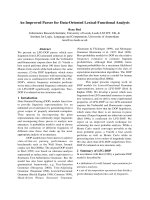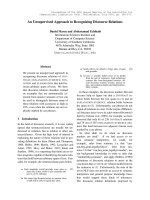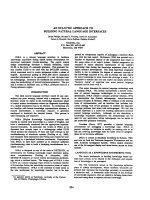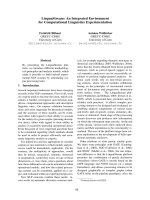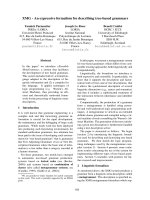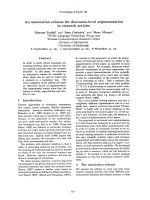Báo cáo khoa học: "An IR Approach for Translating New Words from Nonparallel, Comparable Texts" pot
Bạn đang xem bản rút gọn của tài liệu. Xem và tải ngay bản đầy đủ của tài liệu tại đây (597.13 KB, 7 trang )
An IR Approach for Translating New Words
from Nonparallel, Comparable Texts
Pascale Fung and Lo Yuen Yee
HKUST
Human Language Technology Center
Department of Electrical and Electronic Engineering
University of Science and Technology
Clear Water Bay, Hong Kong
{pascale, eeyy}©ee, ust. hk
1 Introduction
In recent years, there is a phenomenal growth
in the amount of online text material available
from the greatest information repository known
as the World Wide Web. Various traditional
information retrieval(IR) techniques combined
with natural language processing(NLP) tech-
niques have been re-targeted to enable efficient
access of the WWW search engines, indexing,
relevance feedback, query term and keyword
weighting, document analysis, document clas-
sification, etc. Most of these techniques aim at
efficient online search for information already on
the Web.
Meanwhile, the corpus linguistic community
regards the WWW as a vast potential of cor-
pus resources. It is now possible to download
a large amount of texts with automatic tools
when one needs to compute, for example, a
list of synonyms; or download domain-specific
monolingual texts by specifying a keyword to
the search engine, and then use this text to ex-
tract domain-specific terms. It remains to be
seen how we can also make use of the multilin-
gual texts as NLP resources.
In the years since the appearance of the first
papers on using statistical models for bilin-
gual lexicon compilation and machine transla-
tion(Brown et al., 1993; Brown et al., 1991;
Gale and Church, 1993; Church, 1993; Simard
et al., 1992), large amount of human effort and
time has been invested in collecting parallel cor-
pora of translated texts. Our goal is to alleviate
this effort and enlarge the scope of corpus re-
sources by looking into monolingual, compara-
ble texts. This type of texts are known as non-
parallel corpora. Such nonparallel, monolingual
texts should be much more prevalent than par-
allel texts. However, previous attempts at using
nonparallel corpora for terminology translation
were constrained by the inadequate availability
of same-domain, comparable texts in electronic
form. The type of nonparallel texts obtained
from the LDC or university libraries were of-
ten restricted, and were usually out-of-date as
soon as they became available. For new word
translation, the timeliness of corpus resources
is a prerequisite, so is the continuous and au-
tomatic availability of nonparallel, comparable
texts in electronic form. Data collection ef-
fort should not inhibit the actual translation
effort. Fortunately, nowadays the World Wide
Web provides us with a daily increase of fresh,
up-to-date multilingual material, together with
the archived versions, all easily downloadable by
software tools running in the background. It is
possible to specify the URL of the online site of
a newspaper, and the start and end dates, and
automatically download all the daily newspaper
materials between those dates.
In this paper, we describe a new method
which combines IR and NLP techniques to ex-
tract new word translation from automatically
downloaded English-Chinese nonparallel news-
paper texts.
2 Encountering new words
To improve the performance of a machine trans-
lation system, it is often necessary to update
its bilingual lexicon, either by human lexicog-
raphers or statistical methods using large cor-
pora. Up until recently, statistical bilingual lex-
icon compilation relies largely on parallel cor-
pora. This is an undesirable constraint at times.
In using a broad-coverage English-Chinese MT
system to translate some text recently, we dis-
covered that it is unable to translate ~,~,/li-
ougan which occurs very frequently in the text.
Other words which the system cannot find in
its 20,000-entry lexicon include proper names
414
such as the Taiwanese president
Lee Teng-Hui,
and the Hong Kong Chief Executive
Tung Chee-
Hwa.
To our disappointment, we cannot lo-
cate any parallel texts which include such words
since they only start to appear frequently in re-
cent months.
A quick search on the Web turned up archives
of multiple local newspapers in English and Chi-
nese. Our challenge is to find the translation of
~/liougan
and other words from this online
nonparallel, comparable corpus of newspaper
materials. We choose to use issues of the En-
glish newspaper
Hong Kong Standard
and the
Chinese newspaper
Mingpao,
from Dec.12,97 to
Dec.31,97, as our corpus. The English text con-
tains about 3 Mb of text whereas the Chinese
text contains 8.8 Mb of 2 byte character texts.
So both texts are comparable in size. Since they
are both local mainstream newspapers, it is rea-
sonable to assume that their contents are com-
parable as well.
3 YL~,/liougan
is associated with
flu
but not with
Africa
Unlike in parallel texts, the position of a word
in a text does not give us information about its
translation in the other language. (Rapp, 1995;
Fung and McKeown, 1997) suggest that a con-
tent word is closely associated with some words
in its context. As a tutorial example, we postu-
late that the words which appear in the context
of
~/liougan
should be
similar
to the words
appearing in the context of its English trans-
lation,
flu.
We can form a vector space model
of a word in terms of its context word indices,
similar to the vector space model of a text in
terms of its constituent word indices (Salton and
Buckley, 1988; Salton and Yang, 1973; Croft,
1984; Turtle and Croft, 1992; Bookstein, 1983;
Korfhage, 1995; Jones, 1979).
The value of the i-th dimension of a word
vector W is f if the i-th word in the lexicon
appears f times in the
same sentences as W.
Left columns in Table 1 and Table 2 show
the list of content words which appear most fre-
quently in the context of
flu
and
Africa
respec-
tively. The right column shows those which oc-
cur most frequently in the context of ~,~,. We
can see that the context of ~ is more similar
to that of
flu
than to that of
Africa.
Table 1: ~ and
flu
have similar contexts
English Freq.
bird 170
virus 26
spread 17
people 17
government 13
avian 11
scare 10
deadly 10
new 10
suspected 9
chickens 9
spreading 8
prevent 8
crisis 8
health 8
symptoms 7
Chinese Freq.
~ (virus) 147
]:~ (citizen) 90
~'~ (nong Kong) 84
,~ (infection) 69
~ (confirmed) 62
~-~ (show)
62
~ (discover) 56
[~[] (yesterday)
54
~i~ j~ (patient) 53
~i]~ (suspected) 50
~- (doctor) 49
~_t2 (infected) 47
~y~ (hospital) 44
~:~ (no)
42
~ (government) 41
$~1= (event) 40
Table 2: ~ and
Africa
have different contexts
English Freq.
South 109
African 32
China 20
ties 15
diplomatic 14
Taiwan 12
relations 9
Test 9
Mandela 8
Taipei 7
Africans 7
January 7
visit 6
tense 6
survived 6
Beijing 6
Chinese Freq.
~j~ (virus) 147
~ (citizen) 90
~ (Uong Kong) 84
,~ (infection) 69
-~J~ (confirmed) 62
~p-~ (show)
62
• ~.t~ (discover) 56
I~ [] (yesterday) 54
~j~ (patient) 53
~ (suspected) 50
~ (doctor) 49
~l" (infected) 47
~ (hospital) 44
bq~ (no)
42
~[ J~J: (government) 41
~: (event) 40
4 Bilingual lexicon as seed words
So the first clue to the similarity between a word
and its translation number of common words in
their contexts. In a bilingual corpus, the "com-
mon word" is actually a bilingual word pair. We
use the lexicon of the MT system to "bridge" all
bilingual word pairs in the corpora. These word
pairs are used as seed words.
We found that the contexts of
flu
and ~,~
/liougan
share 233 "common" context words,
whereas the contexts of
Africa
and ~,~/liougan
share only 121 common words, even though the
context
of flu
has 491 unique words and the con-
text of
Africa
has 328 words.
In the vector space model,
W[flu]
and
W[liougan]
has 233 overlapping dimensions,
whereas there are 121 overlapping dimensions
between
W[flu]
and
W[A frica].
415
5 Using TF/IDF of contextual
seed
words
The flu example illustrates that the actual rank-
ing of the context word frequencies provides a
second clue to the similarity between a bilingual
word pair. For example, virus ranks very high
for both flu and ~g~/liougan and is a strong
"bridge" between this bilingual word pair. This
leads us to use the term frequency(TF) mea-
sure. The TF of a context word is defined as
the frequency of the word in the context of W.
(e.g. TF of virus in flu is 26, in ~,~ is 147).
However, the TF of a word is not indepen-
dent of its general usage frequency. In an ex-
treme case, the function word the appears most
frequently in English texts and would have the
highest TF in the context of any W. In our HK-
Standard/Mingpao corpus, Hong Kong is the
most frequent content word which appears ev-
erywhere. So in the flu example, we would like
to reduce the significance of Hong Kong's TF
while keeping that of virus. A common way to
account for this difference is by using the inverse
document frequency(IDF). Among the variants
of IDF, we choose the following representation
from (Jones, 1979):
maxn
IDF = log +l
ni
where maxn = the maximum frequency of
any word in the corpus
ni = the total number of occurrences
of word i in the corpus
The IDF of virus is 1.81 and that of Hong
Kong is 1.23 in the English text. The IDF of
~,~ is 1.92 and that of Hong Kong is 0.83 in
Chinese. So in both cases, virus is a stronger
"bridge" for ~,~,/liougan than Hong Kong.
Hence, for every context seed word i, we as-
sign a word weighting factor (Salton and
Buckley, 1988) wi = TFiw x IDFi where TFiw
is the TF of word i in the context of word W.
The updated vector space model of word W has
wi in its i-th dimension.
The ranking of the 20 words in the contexts
of ~/liougan is rearranged by this weighting
factor as shown in Table3.
Table 3: virus is a
Kong
bird 259.97
spread 51.41
virus 47.07
avian 43.41
scare 36.65
deadly 35.15
spreading 30.49
suspected 28.83
symptoms 28.43
prevent 26.93
people 23.09
crisis 22.72
health 21.97
new 17.80
government 16.04
chickens 15.12
stronger bridge than Hong
~iij~ (virus) 282.70
,1~, ~1~ (infection) 187.50
i=~i~ (citizens) 163.49
LI~ (confirmed) 161.89
~[-_ (infected) 158.43
~ijj~ (patient) 132.14
~i~ (suspected) 123.08
U~:~_ (doctor) 108.54
U~ (hospital) 102.73
~ (discover) 98.09
~J~ ~: (event) 83.75
~ (Hong Kong) 69.68
[~ [] (yesterday) 66.84
~ ~ (possible) 60.20
~p-~ (no) 59.76
~ (government) 59.41
6 Ranking translation candidates
Next, a ranking algorithm is needed to match
the unknown word vectors to their counterparts
in the other language. A ranking algorithm se-
lects the best target language candidate for a
source language word according to direct com-
parison of some similarity measures (Frakes and
Baeza-Yates, 1992).
We modify the similarity measure proposed
by (Salton and Buckley, 1988) into the following
SO:
so(wc, We) =
t .2
~/~'~i=l Wzc
where Wic = TFic
Wie = T Fie
~=1
(Wic X Wie )
t 2
X Y]~i=lWie
Variants of similarity measures such as the
above have been used extensively in the IR com-
munity (Frakes and Baeza-Yates, 1992). They
are mostly based on the Cosine Measure of two
vectors. For different tasks, the weighting fac-
tor might vary. For example, if we add the IDF
into the weighting factor, we get the following
measure SI:
t
SI(Wc, We)
=
~i=l(Wic
× Wie)
t .2 t 2
~/~i=lWzc X ~i=lWie
where wic = TFic x IDFi
Wie = TFie x IDFi
416
In addition, the Dice and Jaccard coefficients
are also suitable similarity measures for doc-
ument comparison (Frakes and Baeza-Yates,
1992). We also implement the Dice coefficient
into similarity measure $2:
t
2Ei=l (Wic X Wie)
S2(W , We) = t .2 t .2
~i=l W2c "~- ~i=l W~e
where Wic = TFic x IDFi
Wie = TFie x IDFi
S1 is often used in comparing a short query
with a document text, whereas $2 is used in
comparing two document texts. Reasoning that
our objective falls somewhere in between we
are comparing segments of a document, we also
multiply the above two measures into a third
similarity measure $3.
7 Confidence on seed word pairs
In using bilingual seed words such as IN~/virus
as "bridges" for terminology translation, the
quality of the bilingual seed lexicon naturally
affects the system output. In the case of Eu-
ropean language pairs such as French-English,
we can envision using words sharing common
cognates as these "bridges". Most importantly,
we can assume that the word boundaries are
similar in French and English. However, the
situation is messier with English and Chinese.
First, segmentation of the Chinese text into
words already introduces some ambiguity of the
seed word identities. Secondly, English-Chinese
translations are complicated by the fact that
the two languages share very little stemming
properties, or part-of-speech set, or word order.
This property causes every English word to have
many Chinese translations and vice versa. In a
source-target language translation scenario, the
translated text can be "rearranged" and cleaned
up by a monolingual language model in the tar-
get language. However, the lexicon is not very
reliable in establishing "bridges" between non-
parallel English-Chinese texts. To compensate
for this ambiguity in the seed lexicon, we intro-
duce a confidence weighting to each bilingual
word pair used as seed words. If a word ie is the
k-th candidate for word ic, then wi,~ = wi,~/ki.
The similarity scores then become $4 and $5
and $6 = $4 x $5:
~=l(Wic × Wie)/ki
S4(Wc, We) =
t
.2
t
2
~/~i=lWzc × ~i=lWie
where wic = TFic × IDFi
Wie = TFie x IDFi
2~=l(Wic x Wie)/ki
s5(wc, we) =
t .2
t
2
Ei=lWzc + ~i=lWie
where wic = TFic x IDFi
wie = TFie x IDFi
We also experiment with other combinations
of the similarity scores such as $7 SO x $5.
All similarity measures $3 - $7 are used in the
experiment for finding a translation for ~,~,.
8 Results
In order to apply the above algorithm to find the
translation for ~/liougan from the HKStan-
dard/Mingpao corpus, we first use a script to
select the 118 English content words which are
not in the lexicon as possible candidates. Using
similarity measures $3-$7, the highest ranking
candidates of ~ are shown in Table 6. $6 and
$7 appear to be the best similarity measures.
We then test the algorithm with $7 on more
Chinese words which are not found in the lex-
icon but which occur frequently enough in the
Mingpao texts. A statistical new word extrac-
tion tool can be used to find these words. The
unknown Chinese words and their English coun-
terparts, as well as the occurrence frequencies of
these words in HKStandard/Mingpao are shown
in Table 4. Frequency numbers with a * in-
dicates that this word does not occur frequent
enough to be found. Chinese words with a *
indicates that it is a word with segmentation
and translation ambiguities. For example,
(Lam) could be a family name, or part of an-
other word meaning forest. When it is used as
a family name, it could be transliterated into
Lam in Cantonese or Lin in Mandarin.
Disregarding all entries with a * in the above
table, we apply the algorithm to the rest of the
Chinese unknown words and the 118 English un-
known words from HKStandard. The output is
ranked by the similarity scores. The highest
ranking translated pairs are shown in Table 5.
The only Chinese unknown words which are
not correctly translated in the above list are
417
Table 4: Unknown words which occur often
Freq. Chinese
59 ~'~ (Causeway)
1965 ~J (Chau)*
481 ~ (Chee-hwa)
115 ~ (Chek)*
164 ~ ~J~ (Diana)
3164 ~j (Fong)*
2274 ~ (HONG)
1128 ~ (Huang)*
477 ~
(Ip)*
1404 ~ (Lam)*
687 ~lJ (Lau)*
324 I~ (Lei)
967 ~ (Leung)
312
A~
(Lunar)
164 ~'$~ (Minister)
949 ~,)~ (Personal)
56 ~~ (Pornography)
493 ~$I (Poultry)
1027 :~.]~ (President)
946 ~,~ (Qian)*
154 ~]~ (Qichen)
824 ~j~
(SAR)
325 -~
(Tam)*
281 ~
(Tang)
307 ~_}~ (Teng-hui)
350 ~ (Tuen)
lO52
t
(Tung)
79 ¢tl~. (Versace)*
107 ~J~ (Yeltsin)
ll2 ~ (Zhuhai)
1171 ~ (flu)
Freq. English
37* Causeway
49 Chau
77 Chee-hwa
28 Chek
100 Diana
32 Fong
60 HONG
30 Huang
32 Ip
175 Lam
111 Lau
30 Lei
145 Leung
36 Lunar
197 Minister
8* Personal
13" Pornography
57 Poultry
239 President
62 Qian
28* Qichen
142 SAR
154 Tam
80 Tang
37 Teng-hui
76 Tuen
274 Tung
74 Versace
100 Yeltsin
76 Zhuhai
491 flu
~/Lunar
and
~J~/Yeltsin
I.
Tung/Chee-
Hwa
is a pair of collocates which is actually
the full name of the Chief Executive.
Poultry
in Chinese is closely related to
flu
because the
Chinese name for
bird flu
is
poultry flu.
In
fact,
almost
all unambiguous Chinese new words find
their translations in the first 100 of the ranked
list. Six of the Chinese words have correct trans-
lation as their first
candidate.
9 Related work
Using vector space model and similarity mea-
sures for ranking is a common approach in
IR for query/text and text/text comparisons
(Salton and Buckley, 1988; Salton and Yang,
1973; Croft, 1984; Turtle and Croft, 1992; Book-
stein, 1983; Korfhage, 1995; Jones, 1979). This
approach has also been used by (Dagan and Itai,
1994; Gale et al., 1992; Shiitze, 1992; Gale et
al., 1993; Yarowsky, 1995; Gale and
Church,
1Lunar is not an unknown word in English, Yeltsin
finds its translation in the 4-th candidate.
Table 5:
tion out
score
0.008421
0.007895
0.007669
0.007588
0.007283
0.006812
0.006430
0.006218
0.005921
0.005527
0.005335
0.005335
0.005221
0.004731
0.004470
0.004275
0.003878
0.003859
0.003859
0.003784
0.003686
0.003550
0.003519
0.003481
0.003407
0.003407
0.003338
0.003324
Some
Chinese
)ut
English
Teng-hui
SAR
flu
Lei
poultry
SAR
hijack
poultry
Tung
Diaoyu
PrimeMinister
President
China
Lien
poultry
China
flu
PrimeMinister
President
poultry
Kalkanov
poultry
SAR
Zhuhai
PrimeMinister
President
flu
apologise
unknown word transla-
Chinese
~}~ (Weng-hui)
~
(~u)
(Lei)
~j~ (Poultry)
~ (Chee-hwa)
~}~ (Teng-hui)
~#~ (SAR)
~'~ (Chee-hwa)
:~ (Teng-hui)
~}~ (Weng-hui)
W}~
(Weng-hui)
CLam)
~}~ (Teng-hui)
~-~ (Chee-hwa)
~_}~ (Teng-hui)
(Lei)
~'~ (Chee-hwa)
~'~ (Chee-hwa)
.~ (Leung)
~ (Zhuhai)
I~ (Lei)
~J~ (Yeltsin)
~-~ (Chee-hwa)
)~ (Lam)
(Lam)
~j~ (Poultry)
W~
(Teng-hui)
0.003250 DPP
0.003206 Tang
0.003202 Tung
0.003040 Leung
0.003033 China
0.002888 Zhuhai
0.002886 Tung
~}~ (Teng-hui)
(Tang)
(Leung)
(Leung)
~#~ (SAR)
~ (Lunar)
(Tung)
1994) for sense disambiguation between mul-
tiple usages of the same word. Some of the
early statistical terminology translation meth-
ods are (Brown et al., 1993; Wu and Xia, 1994;
Dagan and Church, 1994; Gale and Church,
1991; Kupiec, 1993; Smadja et al., 1996; Kay
and RSscheisen, 1993; Fung and Church, 1994;
Fung, 1995b). These algorithms all require par-
allel, translated texts as input. Attempts at
exploring nonparallel corpora for terminology
translation are very few (Rapp, 1995; Fung,
1995a; Fung and McKeown, 1997). Among
these, (Rapp, 1995) proposes that the associ-
ation between a word and its close collocate
is preserved in any language, and (Fung and
McKeown, 1997) suggests that the associations
between a word and many seed words are also
preserved in another language. In this paper,
418
we have demonstrated that the associations be-
tween a word and its context seed words are
well-preserved in nonparallel, comparable texts
of different languages.
10
Discussions
Our algorithm is the first to have generated a
collocation bilingual lexicon, albeit small, from
a nonparallel, comparable corpus. We have
shown that the algorithm has good precision,
but the recall is low due to the difficulty in
extracting unambiguous Chinese and English
words.
Better results can be obtained when the fol-
lowing changes are made:
• improve seed word lexicon reliability by
stemming and POS tagging on both En-
glish and Chinese texts;
• improve Chinese segmentation by using a
larger monolingual Chinese lexicon;
• use larger corpus to generate more un-
known words and their candidates by sta-
tistical methods;
We will test the precision and recall of the
algorithm on a larger set of unknown words.
11 Conclusions
We have devised an algorithm using context
seed word TF/IDF for extracting bilingual
lexicon from nonparallel, comparable cor-
pus in English-Chinese. This algorithm takes
into account the reliability of bilingual seed
words and is language independent. This al-
gorithm can be applied to other language pairs
such as English-French or English-German. In
these cases, since the languages are more sim-
ilar linguistically and the seed word lexicon is
more reliable, the algorithm should yield bet-
ter results. This algorithm can also be applied
in an iterative fashion where high-ranking bilin-
gual word pairs can be added to the seed word
list, which in turn can yield more new bilingual
word pairs.
References
A. Bookstein. 1983. Explanation and generalization of vector
models in information retrieval. In
Proceedings of the 6th
Annual International Conference on Research and Devel-
opment in Information Retrieval,
pages 118-132.
P. Brown, J. Lai, and R. Mercer. 1991. Aligning sentences in
parallel corpora. In
Proceedings of the P9th Annual Con-
ference of the Association for Computational Linguistics.
Table 6: English words most similar to
~,~/li-
ougan
SO
0.181114 Lei ~
0.088879 flu b'-~,~
0.085886 Tang ~,l~
0.081411
Ap ~'~
$4
0.120879 flu ~,~
0.097577 Lei ~,~
0.068657 Beijing ~r~
0.065833 poultry ~,r~,
$5
0.086287 flu ~r-~,
0.040090 China ]~:~
0.028157 poultry ~7"~
0.024500 Beijing ~,~,
$6
0.010430 flu ~
0.001854 poultry ~,-~1-~,
0.001840 China ~,~,
0.001682 Beijing ~:~
$7
0.007669 flu ~r'~,
0.001956 poultry ~l-n~,
0.001669 China ~1~
0.001391 Beijing ~1~
P.F. Brown, S.A. Della Pietra, V.J. Della Pietra, and R.L.
Mercer. 1993. The mathematics of machine transla-
tion: Parameter estimation.
Computational Linguistics,
19(2):263-311.
Kenneth Church. 1993. Char.align: A program for aligning
parallel texts at the character level. In
Proceedings of the
31st Annual Conference of the Association for Computa-
tional Linguistics,
pages 1-8, Columbus, Ohio, June.
W. Bruce Croft. 1984. A comparison of the cosine correla-
tion and the modified probabilistic model. In
Information
Technology,
volume 3, pages 113-114.
Ido Dagan and Kenneth W. Church. 1994. Termight: Iden-
tifying and translating technical terminology. In
Proceed-
ings of the 4th Conference on Applied Natural Language
Processing,
pages 34-40, Stuttgart, Germany, October.
Ido Dagan and Alon Itai. 1994. Word sense disambiguation
using a second language monolingual corpus. In
Compu-
tational Linguistics,
pages 564-596.
William B. Frakes and Ricardo Baeza-Yates, editors. 1992.
Information Retrieval: Data structures ~ Algorithms.
Prentice-Hall.
Pascale Fung and Kenneth Church. 1994. Kvec: A new ap-
proach for aligning parallel texts. In
Proceedings of COL-
ING 9J,
pages 1096-1102, Kyoto, Japan, August.
Pascale Fung and Kathleen McKeown. 1997. Finding termi-
nology translations from non-parallel corpora. In
The 5th
Annual Workshop on Very Large Corpora,
pages 192-202,
Hong Kong, Aug.
Pascale Fung and Dekai Wu. 1994. Statistical augmentation
of a Chinese machine-readable dictionary. In
Proceedings
of the Second Annual Workshop on Very Large Corpora,
pages 69-85, Kyoto, Japan, June.
419
Pascale Fung. 1995a. Compiling bilingual lexicon entries from
a non-parallel English-Chinese corpus. In
Proceedings of
the Third Annual Workshop on Very Large Corpora,
pages
173-183, Boston, Massachusettes, June.
Pascale Fung. 1995b. A pattern matching method for find-
ing noun and proper noun translations from noisy parallel
corpora. In
Proceedings of the 33rd Annual Conference of
the Association for Computational Linguistics,
pages 236-
233, Boston, Massachusettes, June.
William Gale and Kenneth Church. 1991. Identifying word
correspondences in parallel text. In
Proceedings of the
Fourth Darpa Workshop on Speech and Natural Language,
Asilomar.
William A. Gale and Kenneth W. Church. 1993. A program
for aligning sentences in bilingual corpora.
Computational
Linguistics,
19(1):75-102.
William A. Gale and Kenneth W. Church. 1994. Discrim-
ination decisions in 100,000 dimensional spaces.
Current
Issues in Computational Linguisitcs: In honour of Don
Walker,
pages 429-550.
W. Gale, K. Church, and D. Yarowsky. 1992. Estimating
upper and lower bounds on the performance of word-sense
disambiguation programs. In
Proceedings of the 30th Con-
ference of the Association for Computational Linguistics.
Association for Computational Linguistics.
W. Gale, K. Church, and D. Yarowsky. 1993. A method for
disambiguating word senses in a large corpus. In
Comput-
ers and Humanities,
volume 26, pages 415-439.
K. Sparck Jones. 1979. Experiments in relevance weighting
of search terms. In
Information Processing and Manage-
ment,
pages 133-144.
Martin Kay and Martin R6scheisen. 1993. Text-Translation
alignment.
Computational Linguistics,
19(1):121-142.
Robert Korfhage. 1995. Some thoughts on similarity mea-
sures. In
The SIGIR Forum,
volume 29, page 8.
Julian Kupiec. 1993. An algorithm for finding noun phrase
correspondences in bilingual corpora. In
Proceedings of the
31st Annual Conference of the Association for Computa-
tional Linguistics,
pages 17-22, Columbus, Ohio, June.
Reinhard Rapp. 1995. Identifying word translations in non-
parallel texts. In
Proceedings of the 35th Conference of
the Association of Computational Linguistics, student ses-
sion,
pages 321-322, Boston, Mass.
G. Salton and C. Buckley. 1988. Term-weighting approaches
in automatic text retrieval. In
Information Processing and
Management,
pages 513-523.
G. Salton and C. Yang. 1973.
On the specification of term
values in automatic indexing,
volume 29.
Hinrich Shiitze. 1992. Dimensions of meaning. In
Proceedings
of Supercomputing '92.
M. Simard, G Foster, and P. Isabelle. 1992. Using cognates
to align sentences in bilingual corpora. In
Proceedings
of the Forth International Conference on Theoretical and
Methodological Issues in Machine Translation,
Montreal,
Canada.
Frank Smadja, Kathleen McKeown, and Vasileios Hatzsivas-
siloglou. 1996. Translating collocations for bilingual lexi-
cons: A statistical approach.
Computational Linguistics,
21(4):1-38.
Howard R. Turtle and W. Bruce Croft. 1992. A compari-
son of text retrieval methods. In
The Computer Journal,
volume 35, pages 279-290.
Dekai Wu and Xuanyin Xia. 1994. Learning an English-
Chinese lexicon from a parallel corpus. In
Proceedings
of the First Conference of the Association for Machine
Translation in the Americas,
pages 206-213, Columbia,
Maryland, October.
D. Yarowsky. 1995. Unsupervised word sense disambiguation
rivaling supervised methods. In
Proceedings of the 33rd
Conference o.f the Association for Computational Linguis-
tics,
pages 189-196. Association for Computational Lin-
guistics.
420



